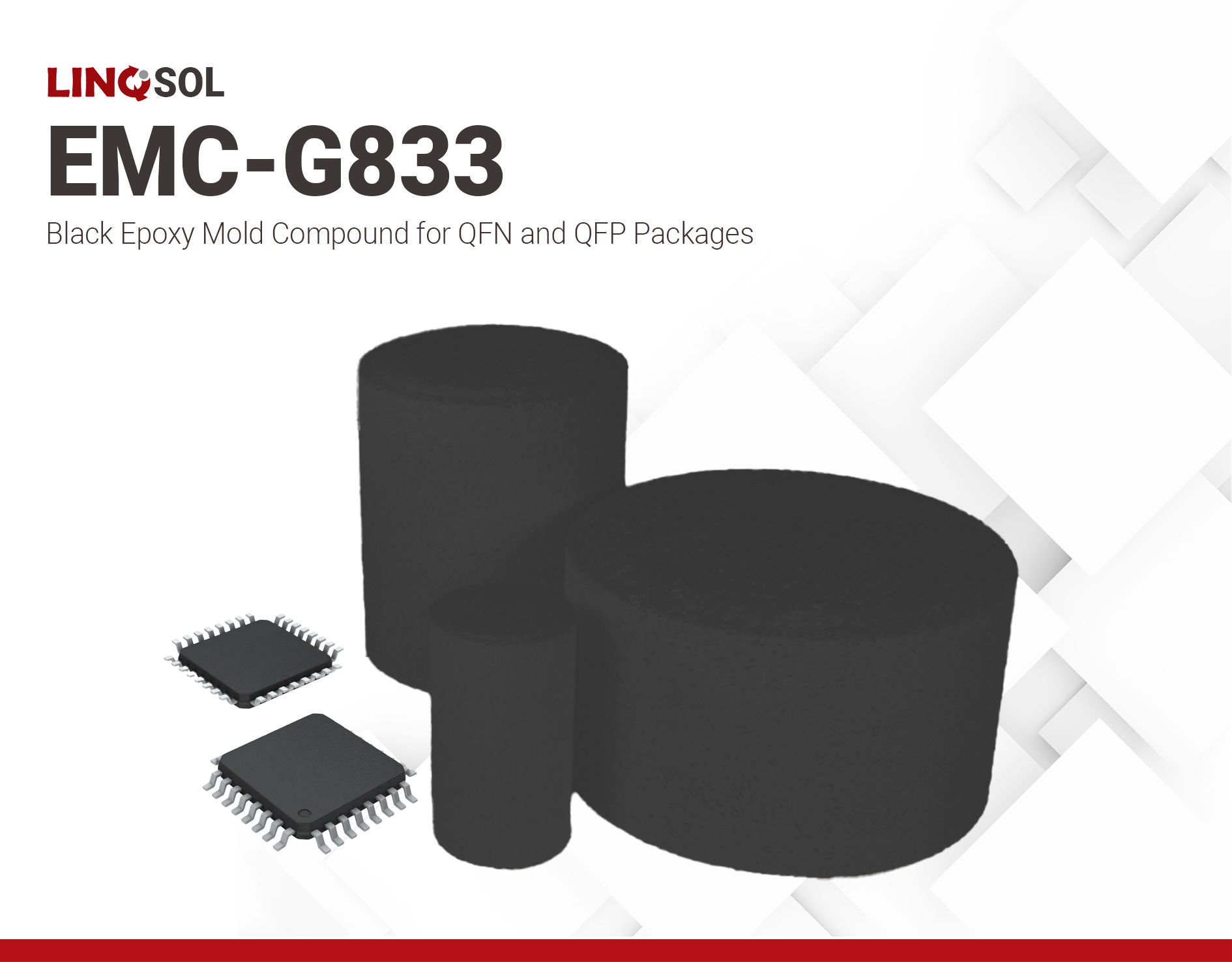LINQSOL EMC-G833 | Black Epoxy Mold Compound
- Green epoxy molding compound
- Designed for Quad Flat No Leads(QFN), Quad Flat (QFP) packages and DFN Packages
- Excellent reliability performance
Product Description
LINQSOL EMC-G833 is a green epoxy molding compound specifically developed for the encapsulation of Quad Flat No Leads(QFN), Quad Flat (QFP) packages and other surface mount packages. Its wide gel time provides a better processing window, required for QFN, DFN nd QFP molding.
LINQSOL EMC-G833 has a high spiral flow that meets higher flowability requirements. Additionally, with a UL 94 V-0 flammability rating and ultra-low water absorption, EMC-G833 guarantees excellent performance and outstanding reliability. This product is deliberately formulated without the inclusion of substances prohibited by the European Union RoHS and REACH.
Overall, LINQSOL EMC-G833 seamlessly integrates advanced material properties, safety compliance, and superior performance to deliver a reliable solution for semiconductor device encapsulation.
Available Variants
- LINQSOL EMC-G833 Standard Epoxy Mold compound for MSL 3 QFN, DFN and QFP.
- LINQSOL EMC-G833R MSL 1 Capable
Reliability Tests Passed:
- Preconditioning: 30°C, 60% RH
- u-HAST: T=130°C, RH= 85%, P= 230kPa
- PCT, Tₐ=121°C, P=205 kPa, RH=100%* 168 hours
- TCT, –65 to 150 °C * 1000 cycles
- HTST, T=150°C * 1000 hours
Technical Specifications
| General Properties | |||||||
| Color Color The color | Black | ||||||
| Filler Content | 87 % | ||||||
| Specific Gravity Specific Gravity Specific gravity (SG) is the ratio of the density of a substance to the density of a reference substance; equivalently, it is the ratio of the mass of a substance to the mass of a reference substance for the same given volume. For liquids, the reference substance is almost always water (1), while for gases, it is air (1.18) at room temperature. Specific gravity is unitless. | 1.97 | ||||||
| |||||||
| Thermal Properties | |||||||
| Glass Transition Temperature (Tg) Glass Transition Temperature (Tg) The glass transition temperature for organic adhesives is a temperature region where the polymers change from glassy and brittle to soft and rubbery. Increasing the temperature further continues the softening process as the viscosity drops too. Temperatures between the glass transition temperature and below the decomposition point of the adhesive are the best region for bonding. The glass-transition temperature Tg of a material characterizes the range of temperatures over which this glass transition occurs. | 112 °C | ||||||
| UL 94 Rating UL 94 Rating Flammability rating classification. It determines how fast a material burns or extinguishes once it is ignited. HB: slow burning on a horizontal specimen; burning rate less than 76 mm/min for thickness less than 3 mm or burning stops before 100 mm V-2: burning stops within 30 seconds on a vertical specimen; drips of flaming particles are allowed. V-1: burning stops within 30 seconds on a vertical specimen; drips of particles allowed as long as they are not inflamed. V-0: burning stops within 10 seconds on a vertical specimen; drips of particles allowed as long as they are not inflamed. 5VB: burning stops within 60 seconds on a vertical specimen; no drips allowed; plaque specimens may develop a hole. 5VA: burning stops within 60 seconds on a vertical specimen; no drips allowed; plaque specimens may not develop a hole | V-0 | ||||||
| |||||||
| |||||||
| Electrical Properties | |||||||
| |||||||
| Chemical Properties | |||||||
| |||||||
| Physical Properties | |||||||
| Spiral Flow @ 175°C | 165 cm | ||||||
| Mechanical Properties | |||||||
| |||||||
| |||||||
| Curing Conditions | |||||||
| Transfer Pressure | 70-150 kg/cm2 | ||||||
| Transfer Time | 8-25 s | ||||||
| |||||||
| |||||||
Additional Information
| PROPERTY | UNIT | EMC-G833 | EMC-G833R |
Color | – | Black | Black |
Filler content | % | 87 | 88 |
Filler cut size | µm | 75 | 75 |
Specific gravity | – | 1.97 | 2.0 |
Spiral flow at 175 °C | cm | 165 | 150 |
Ion content Chloride (Cl–) concentration Sodium (Na+) concentration |
ppm |
6 | 5 5 |
Electrical conductivity of extract | µS⋅cm–1 | 50 | 30 |
Flexural strength | MPa | 145 | 162 |
Flexural modulus | GPa | 22.8 | 24 |
Glass transition temperature | °C | 112 | 118 |
Coefficient of thermal expansion, α1 | ppm/K | 11 | 10 |
Coefficient of thermal expansion, α2 | ppm/K | 36 | 36 |
Gel time at 175 °C | sec | 57 | 52 |
Flammability | UL-94 | V-0 | V-0 |
LINQSOL EMC-G833 Storage and Handling
LINQSOL EMC-G833 is available in pressed pellets in a wide range of sizes to meet specific customer needs. To ensure product integrity, keep it away from oxidizing materials. For long-term storage, maintain a cold environment. The shelf life when stored below 5 °C is 183 days.
Please note that the provided information is based on available data and typical conditions. For specific applications and detailed test results, refer to the actual test data and conduct appropriate certifications.



